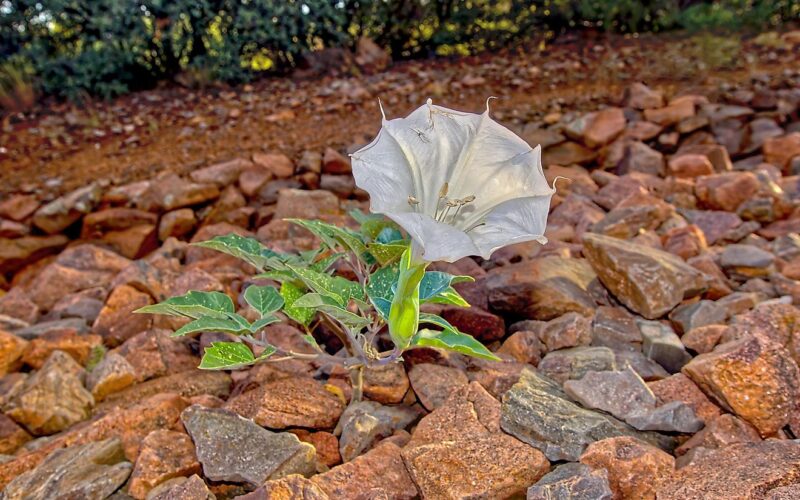Arizona’s desert landscape might look serene, but beneath that beauty lurks a collection of plants that can seriously harm you.
Whether you’re hiking through Saguaro National Park or simply maintaining your backyard, knowing which plants to avoid could save you from a trip to the emergency room—or worse.
The Sonoran Desert doesn’t mess around when it comes to plant defense mechanisms.
From razor-sharp spines that can pierce hiking boots to toxins potent enough to stop a heart, these plants have evolved some seriously effective ways to protect themselves.
Understanding these hazardous desert plants isn’t just academic knowledge—it’s essential safety information that could prevent painful injuries or dangerous poisoning.
Cacti That Can Land You in the Hospital
Saguaro Cactus: The Gentle Giant with a Deadly Secret
You’d think the iconic saguaro would be harmless given its slow-growing, majestic presence, but those spines aren’t just for show. These needle-sharp defenses can penetrate several inches deep, and their barbed structure makes them incredibly difficult to remove completely. Emergency rooms across Arizona regularly treat hikers who’ve had close encounters with saguaro spines, often requiring surgical removal when the spines break off under the skin.
The real danger comes from secondary infections. Even a small puncture wound can become seriously infected if not properly cleaned and treated, especially in Arizona’s dusty environment where bacteria thrive.
Cholla Cactus: The “Jumping” Menace
Don’t let anyone tell you cholla cacti actually jump—they don’t. But their segments detach so easily that the slightest brush against them results in a painful attachment to your skin or clothing. The barbed spines are designed by nature to hitch rides on passing animals, and unfortunately, humans make excellent transportation.
What makes cholla particularly dangerous is how the spines cluster together. You won’t just get one spine—you’ll get dozens, all embedded at different angles. Removing them requires patience and proper tools (pliers work better than tweezers), and rushing the process often drives the spines deeper.
Prickly Pear Cactus: Small Spines, Big Problems
While prickly pear cacti might seem less intimidating than their towering cousins, they pose their own unique hazards. Beyond the obvious large spines, these plants are covered in tiny, nearly invisible spines called glochids. These microscopic needles embed themselves in skin and clothing, causing irritation that can last for weeks.
The glochids are particularly problematic because they’re almost impossible to see without magnification, making complete removal nearly impossible. They work their way deeper into skin over time, causing ongoing irritation and potential infection.
Toxic Plants That Kill
Oleander: Beautiful but Deadly
Oleander’s gorgeous pink and white flowers make it a popular landscaping choice throughout Arizona, but every part of this plant contains cardiac glycosides powerful enough to stop a human heart. Just a few leaves can be fatal if ingested, and even burning oleander releases toxic fumes that can cause respiratory distress.
Children and pets are particularly vulnerable, as the sweet-tasting flowers and leaves don’t immediately signal danger. Many Arizona hospitals keep oleander antidotes on hand specifically because of how common this plant is in residential areas.
Jimsonweed (Datura): The Desert’s Hallucinogenic Killer
Jimsonweed might produce striking trumpet-shaped flowers, but this member of the nightshade family is among the most dangerous plants in Arizona. Every part contains tropane alkaloids that cause violent hallucinations, seizures, and often death. Unlike other hallucinogens, jimsonweed’s effects are unpredictable and impossible to control.
The plant’s seeds are particularly concentrated with toxins, and even small amounts can cause severe poisoning. Emergency room doctors describe jimsonweed poisoning as one of the most difficult to treat because patients often become violent and incoherent.
Poison Hemlock: Ancient Poison in Modern Arizona
This invasive species has spread throughout Arizona’s waterways and disturbed areas, bringing with it the same toxins that killed Socrates. Poison hemlock contains coniine, which causes progressive paralysis starting with the legs and working upward until it reaches the respiratory system.
The plant’s innocent appearance—resembling large parsley or wild carrots—makes it particularly dangerous. Children have been poisoned after using hollow stems as whistles, and adults have mistaken the roots for edible wild carrots.
Industrial-Strength Plant Toxins
Castor Bean Plant: Ricin Factory
Castor bean plants produce some of the most potent toxins found in nature. The seeds contain ricin, a protein that’s lethal in incredibly small amounts—just a few seeds can kill an adult. What makes this plant particularly insidious is that ricin poisoning symptoms don’t appear for hours or even days after exposure.
Despite their toxicity, castor bean plants are sometimes grown ornamentally in Arizona because of their large, attractive leaves. However, the risk simply isn’t worth the aesthetic appeal, especially in households with children or pets.
Tree Tobacco: Nicotine’s Wild Cousin
Tree tobacco might look like a harmless shrub, but it contains nicotine levels far higher than commercial tobacco. The leaves and seeds are particularly dangerous, containing alkaloids that can cause nausea, vomiting, and respiratory paralysis.
This plant spreads aggressively throughout Arizona, often colonizing disturbed areas and roadsides. Its yellow flowers might look appealing, but contact with the leaves can cause skin irritation in sensitive individuals.
Plants That Attack Your Immune System
African Sumac: The Allergy Trigger
African sumac trees are popular in Arizona landscaping because they’re drought-tolerant and fast-growing. However, these plants are closely related to poison ivy and can trigger severe allergic reactions in sensitive individuals. The reaction often doesn’t occur immediately—it can take hours or days to develop.
What makes African sumac particularly problematic is that sensitivity can develop over time. You might handle the plant without problems for years, then suddenly develop a severe reaction. The sap contains urushiol, the same compound that makes poison ivy so miserable.
Desert Broom: The Respiratory Irritant
Desert broom might seem harmless enough, but during its flowering season, this plant releases massive amounts of pollen that can trigger severe respiratory reactions. People with asthma or other breathing conditions are particularly vulnerable.
The plant’s lightweight pollen travels for miles on desert winds, making it difficult to avoid during peak season. Many Arizona residents don’t realize their seasonal respiratory problems are caused by desert broom until they connect the timing with the plant’s flowering cycle.
Chemical Warfare in Plant Form
Pencil Cactus: Toxic Sap Surprise
Despite its name, pencil cactus isn’t actually a cactus—it’s a euphorbium that produces a milky sap containing skin-irritating compounds. Contact with this sap can cause severe burns, and if it gets in your eyes, it can cause temporary or permanent blindness.
The plant’s innocent, stick-like appearance makes it particularly dangerous because people don’t expect such a mild-looking plant to pack such a toxic punch. Garden centers often sell pencil cactus without adequate warnings about its dangers.
Staying Safe in Arizona’s Plant Minefield
Living with these toxic plants in Arizona requires constant awareness and respect for nature’s defensive mechanisms. Always wear protective clothing when hiking or gardening, carry a first aid kit with tweezers and antiseptic, and most importantly, teach children never to touch or taste unknown plants.
When in doubt, maintain a safe distance and appreciate Arizona’s dangerous flora from afar. The desert’s beauty is undeniable, but it demands respect—and knowledge of which plants can turn a pleasant outdoor experience into a medical emergency.
Remember: Arizona’s most dangerous plants have evolved their defenses over millions of years. They’re not going anywhere, so learning to coexist safely with them is your best strategy for enjoying everything the desert has to offer.








